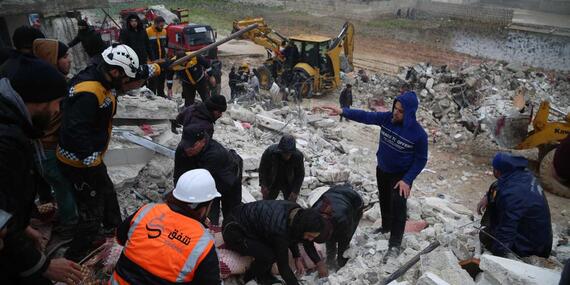Today's top news: Türkiye and Syria, Ukraine

Earthquakes in Türkiye and Syria
The number of casualties in both Türkiye and Syria continues to rise, with many people still trapped under the rubble.
The UN is helping mobilize emergency teams and relief operations. More than 40 Urban Search and Rescue teams from Türkiye and 19 other countries are deployed, with some 2,800 urban search and rescue specialists and 160 search dogs. The majority of these teams are UN International Search and Rescue Advisory Group classified teams and are coordinated by the Turkish Disaster Management Agency (AFAD) and a UN Disaster Assessment and Coordination (UNDAC) team of 45 staff located in hubs throughout affected areas of Gaziantep, Hatay, Adimayan and Kahramanmaras.
A separate UNDAC team is on its way to Syria to support the response there.
In north-west Syria, community-based rescue teams are fully engaged in the ongoing search for people trapped under the debris of collapsed houses. The lack of heavy machines to remove rubble, as well as poor weather conditions, are complicating these efforts. In other parts of Syria, humanitarian actors report there's an urgent need for assistance, logistics, skilled rescue teams, and temporary shelters.
Our colleagues in the field have confirmed today that the Bab al Hawa crossing is accessible. Today, some 90 per cent of the 4.6 million people living in north-west Syria rely on humanitarian assistance to meet their most basic needs. The UN cross-border response, authorized by the Security Council, has served as their humanitarian lifeline. Last year, trucks loaded with aid crossing from Türkiye to north-west Syria reached on average 2.6 million Syrians each month through this operation.
Ukraine
A local hospital in Vovchansk, which is less than 10 km from the Russian-Ukrainian border in the eastern Kharkiv region, was damaged by shelling two days in a row on 6 and 7 February. The first attack caused a massive fire, destroying the roof and prompting the evacuation of the patients from the hospital’s bomb shelter, according to humanitarian workers on the ground.
Over the past two weeks, dozens of health facilities were reportedly damaged by hostilities. At least five attacks on hospitals were reported by local authorities in the Ukrainian-controlled part of the Donetsk region in the east. On the other side of the front line, four health facilities also had their windows damaged, according to the Russian-installed authorities.
Last month, at least two health facilities were damaged in Kherson, including a maternity hospital. In 2022, WHO verified more than 760 attacks on health facilities in Ukraine. These accounted for nearly two-thirds of attacks on health sites globally.
On the humanitarian front, an inter-agency convoy led by the Humanitarian Coordinator, Denise Brown, today delivered aid to Kherson, which continues to experience continuous shelling. Some 65,000 people are estimated to remain in the city and they experience frequent interruptions of basic services — electricity, heating and water supply — in the middle of winter.
The supplies carried in today’s convoy were provided by the International Organization for Migration, the Office of the High Commissioner for Refugees, UNICEF and WHO. They included trauma and emergency surgery kits, emergency shelter materials, mattresses, blankets, winter clothes, heaters, solar lamps, hygiene items and other household items.
